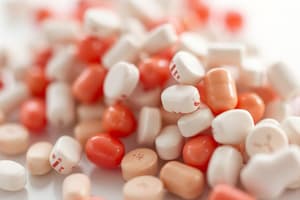Podcast
Questions and Answers
What is a possible consequence of transferring from systemic to inhaled flunisolide?
What is a possible consequence of transferring from systemic to inhaled flunisolide?
- Increased bronchodilation
- Chronic pain relief
- Adrenal insufficiency (correct)
- Decreased dosage requirement
Which condition requires cautious use of corticosteroids due to potential adverse effects?
Which condition requires cautious use of corticosteroids due to potential adverse effects?
- Hyperlipidemia
- Hypertension
- Fungal infections (correct)
- Diabetes mellitus
What treatment approach is indicated for rheumatic disorders?
What treatment approach is indicated for rheumatic disorders?
- Inhaled bronchodilators
- Long-term corticosteroids
- Short-term oral steroids or joint injections (correct)
- High-dose analgesics
Which of the following is a common adverse effect associated with corticosteroid use?
Which of the following is a common adverse effect associated with corticosteroid use?
What is the recommended administration method for corticosteroids whenever feasible?
What is the recommended administration method for corticosteroids whenever feasible?
What is the primary action of corticosteroids on target cells?
What is the primary action of corticosteroids on target cells?
Which corticosteroid is considered the prototype for exogenous corticosteroids?
Which corticosteroid is considered the prototype for exogenous corticosteroids?
What is a common use of corticosteroids in medical treatment?
What is a common use of corticosteroids in medical treatment?
Which of the following disorders would NOT typically be treated with corticosteroids?
Which of the following disorders would NOT typically be treated with corticosteroids?
What effect do corticosteroids have on the inflammatory response?
What effect do corticosteroids have on the inflammatory response?
Which condition is mentioned as a use of corticosteroids for symptom control?
Which condition is mentioned as a use of corticosteroids for symptom control?
What is a possible impact of corticosteroids on lymphocytes?
What is a possible impact of corticosteroids on lymphocytes?
Why are corticosteroids used in organ or tissue transplants?
Why are corticosteroids used in organ or tissue transplants?
Which of the following must be done after the acute symptoms of asthma subside when using adrenergic bronchodilators?
Which of the following must be done after the acute symptoms of asthma subside when using adrenergic bronchodilators?
What is a significant risk associated with the transfer from systemic to inhaled flunisolide?
What is a significant risk associated with the transfer from systemic to inhaled flunisolide?
In which situation is stress dosing of corticosteroids indicated?
In which situation is stress dosing of corticosteroids indicated?
What is a common adverse effect of corticosteroid use related to appearance?
What is a common adverse effect of corticosteroid use related to appearance?
Which of the following conditions should corticosteroids be used cautiously in?
Which of the following conditions should corticosteroids be used cautiously in?
What is the primary effect of corticosteroids on inflammatory responses?
What is the primary effect of corticosteroids on inflammatory responses?
Which of the following is a condition for which corticosteroids are commonly prescribed?
Which of the following is a condition for which corticosteroids are commonly prescribed?
Corticosteroids can be beneficial in managing all of the following conditions EXCEPT:
Corticosteroids can be beneficial in managing all of the following conditions EXCEPT:
What is a significant adverse effect of corticosteroid therapy?
What is a significant adverse effect of corticosteroid therapy?
In which scenario would corticosteroids be utilized to control symptoms?
In which scenario would corticosteroids be utilized to control symptoms?
Corticosteroids have a primary mechanism of action by binding to:
Corticosteroids have a primary mechanism of action by binding to:
Which of the following corticosteroids is recognized as the prototype?
Which of the following corticosteroids is recognized as the prototype?
Corticosteroids can inhibit which of the following cellular processes?
Corticosteroids can inhibit which of the following cellular processes?
Flashcards
Corticosteroids
Corticosteroids
Hormones produced by the adrenal cortex that affect many body organs, crucial for homeostasis in normal amounts.
Exogenous Corticosteroids
Exogenous Corticosteroids
Corticosteroids taken from an outside source (medicine) rather than naturally produced by the body.
Prednisone
Prednisone
A common example of an exogenous corticosteroid, a prototype of the drug class.
Corticosteroid Action
Corticosteroid Action
Signup and view all the flashcards
Inflammatory Reduction
Inflammatory Reduction
Signup and view all the flashcards
Corticosteroid Uses
Corticosteroid Uses
Signup and view all the flashcards
Allergic Rhinitis Treatment
Allergic Rhinitis Treatment
Signup and view all the flashcards
Immunosuppressant Effect
Immunosuppressant Effect
Signup and view all the flashcards
Systemic Corticosteroids
Systemic Corticosteroids
Signup and view all the flashcards
Corticosteroid Tapering
Corticosteroid Tapering
Signup and view all the flashcards
Corticosteroid Stress Dosing
Corticosteroid Stress Dosing
Signup and view all the flashcards
Corticosteroids and Immune Response
Corticosteroids and Immune Response
Signup and view all the flashcards
Licorice and Corticosteroids
Licorice and Corticosteroids
Signup and view all the flashcards
What are the main systemic effects of corticosteroids?
What are the main systemic effects of corticosteroids?
Signup and view all the flashcards
Why are corticosteroids tapered?
Why are corticosteroids tapered?
Signup and view all the flashcards
Stress Dosing
Stress Dosing
Signup and view all the flashcards
Contraindications for Corticosteroids
Contraindications for Corticosteroids
Signup and view all the flashcards
Corticosteroids: What are they?
Corticosteroids: What are they?
Signup and view all the flashcards
Exogenous Corticosteroids: What's the difference?
Exogenous Corticosteroids: What's the difference?
Signup and view all the flashcards
Prednisone: The Prototype
Prednisone: The Prototype
Signup and view all the flashcards
How do Corticosteroids Work: Mechanism
How do Corticosteroids Work: Mechanism
Signup and view all the flashcards
Corticosteroids: What do they treat?
Corticosteroids: What do they treat?
Signup and view all the flashcards
Corticosteroids in Asthma: How do they work?
Corticosteroids in Asthma: How do they work?
Signup and view all the flashcards
Corticosteroids in Neoplastic Disease: The role
Corticosteroids in Neoplastic Disease: The role
Signup and view all the flashcards
Study Notes
Corticosteroids
- Hormones produced by the adrenal cortex, affecting nearly all body organs. Normal levels maintain homeostasis. Imbalance leads to disease.
- Exogenous corticosteroids, such as prednisone (prototype), are used therapeutically. Other drugs include: beclomethasone, betamethasone, budesonide, cortisone, dexamethasone, flunisolide, fluticasone, hydrocortisone, methylprednisolone, prednisolone, and triamcinolone.
- Action involves binding to receptors, influencing protein synthesis, and regulating inflammatory response. This leads to reduced inflammation, decreased edema, reduced chemicals that cause vasodilation, and tissue irritation reducing inflammation. Also affects immune response, inhibiting phagocytosis (cell eating) and lymphocyte function, and influencing tissue repair.
- Uses include treating various conditions - allergic/hypersensitivity disorders (e.g., dermatitis), problems in collagen systems (like SLE), dermatological issues, endocrine disorders (adrenocortical insufficiency), gastrointestinal conditions (ulcerative colitis, Crohn's), hematological problems (e.g., idiopathic thrombocytopenic purpura), hepatic disorders, neoplastic diseases (e.g., leukemia, Hodgkin's lymphoma), and neurologic conditions (e.g., cerebral edema, spinal cord injury).
- Can be taken orally, by injection, inhaled, or applied topically (where appropriate). The method chosen depends on the location and extent of the underlying problem.
Adverse Effects and Considerations
- Chronic use can lead to adrenocortical insufficiency, Cushingoid features (like a distinctive face shape), vertigo, insomnia, compromised immune function.
- Careful use is crucial in renal or hepatic impairment, in the elderly, and in patients with fungal infections.
- Licorice can enhance corticosteroid effects.
- Administration methods may include divided doses or alternate-day/daily dosing. Stress-dosing can help manage conditions worsened by stress or illness.
- Important considerations may include potential issues with live-virus vaccinations if the patient is already using corticosteroids.
Studying That Suits You
Use AI to generate personalized quizzes and flashcards to suit your learning preferences.
Related Documents
Description
This quiz explores the role of corticosteroids produced by the adrenal cortex, their therapeutic uses, and impacts on the body. It covers various corticosteroid drugs, their mechanisms, and the conditions they treat. Test your knowledge on these vital hormones and their application in medicine.



